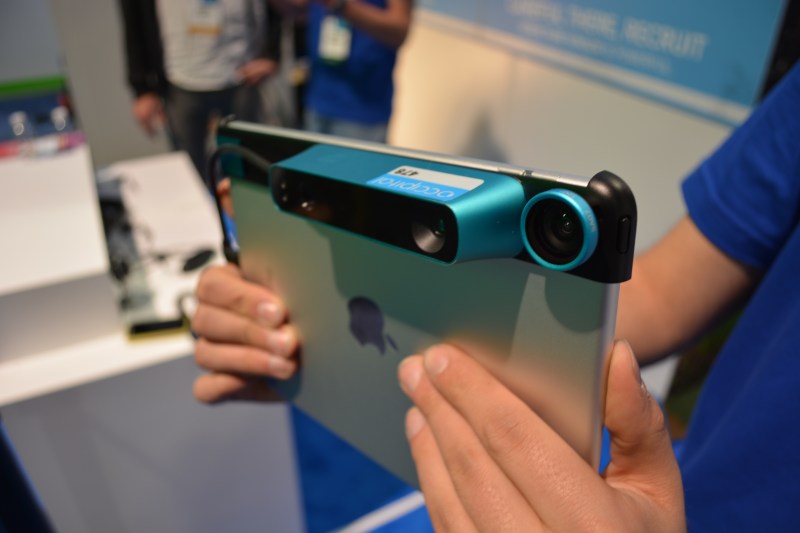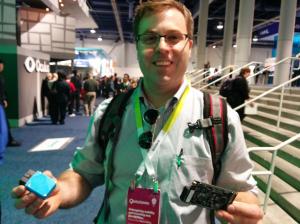My first day on the ground at CES started with a somewhat amusing wait at the Taxi Stand of the McCarran International Airport. Actually I’m getting ahead of myself… it started with a surprisingly efficient badge-pickup booth in the baggage claim of the airport. Wait in line for about three minutes, and show them the QR code emailed to you from online registration and you’re ready to move to the 1/4 mile-long, six-switchback deep line for cabs. Yeah, there’s a lot of people here for this conference.
It’s striking just how huge this thing is. Every hotel on the strip is crawling with badge-wearing CES attendees. Many of the conference halls in the hotels are filled with booths, meaning the thing is spread out over a huge geographic area. We bought three-day monorail passes and headed to the convention center to get started.
Building the Booths
[Sophi] knows [Ben Unsworth] who put his heart and soul into this year’s IEEE booth. His company, Globacore, builds booths for conferences and this one sounds like it was an exceptional amount of fun to work on. He was part of a tiny team that built a mind-controlled drag strip based on Emotive Insight brainwave measuring hardware shipped directly from the first factory production run. This ties in with the display screens above the track to form a leader board. We’ll have a keen eye out for hacks this week, but the story behind building these booths may be the best hack to be found.
Oculus
[Ben] told us hands-down the thing to see is the new Oculus hardware called Crescent Bay. He emphatically mentioned The Holodeck which is a comparison we don’t throw around lightly. Seems like a lot of people feel that way because the line to try it out is wicked long. We downloaded their app which allows you to schedule a demo but all appointments are already taken. Hopefully our Twitter plea will be seen by their crew.
In the meantime we tried out the Oculus Gear VR. It uses a Galaxy Note 4 as the screen along with lenses and a variety of motion tracking and user controls. The demo was a Zelda-like game where you view the scene from overhead. This used a handheld controller to command the in-game character with the headset’s motion tracking used to look around the playing area. It was a neat demo, I’m not quite sold on long gaming sessions with the hardware but maybe I just need to get used full-immersion first.
Window to another Dimension

The midways close at six o’clock and we made our way to the Occipital booth just as they were winding done. I’ve been 3D scanned a few times before but those systems used turntables and depth cameras on motorized tracks to do the work. This uses a depth-camera add-on for an iPad which they call Structure Sensor.
It is striking how quickly the rig can capture a model. This high-speed performance is parlayed into other uses, like creating a virtual world inside the iPad which the user navigates by using the screen as if it were a magic window into another dimension. Their demo was something along the lines of the game Portal and has us thinking that the Wii U controller has the right idea for entertainment, but it needs the performance that Occipital offers. I liked this experience more than the Oculus demo because you are not shut off from the real world as you make your way through the virtual.
We shot some video of the hardware and plan to post more about it as soon as we get the time to edit the footage.
Find Us or Follow Us
 We’re wearing our Hackaday shirts and that stopped [Josh] in his tracks. He’s here on business with his company Evermind, but like any good hacker he is carrying around one of his passion projects in his pocket. What he’s showing off are a couple of prototypes for a CANbus sniffer and interface device that he’s build.
We’re wearing our Hackaday shirts and that stopped [Josh] in his tracks. He’s here on business with his company Evermind, but like any good hacker he is carrying around one of his passion projects in his pocket. What he’s showing off are a couple of prototypes for a CANbus sniffer and interface device that he’s build.
We’ll be at CES all week. You can follow our progress through the following Twitter accounts: @Hackaday, @HackadayPrize, @Szczys, and @SophiKravitz. If you’re here in person you can Tweet us to find where we are. We’re also planning a 9am Thursday Breakfast meetup at SambaLatte in the Monte Carlo. We hope you’ll stop by and say hi. Don’t forget to bring your own hardware!




















If you happen to see the Hamamatsu booth, they’ve borrowed the Arducorder Mini for CES to help demo their micro-spectrometer. I’d love it if someone could snap a picture or two and send them my way!
Always a good idea to explain what CES means first off . Where are your writing skills?
I’m all for spelling out acronyms, but come on dude . if you don’t know that CES is consumer electronics show by now…
Everyone is talking about CES and I was just sitting here wondering what CES is. Cool finaly someone defined it. Thanks :)
I see you explain yours in your post . We are not all on the same page as you . heck I aint even on the same side of the world
Ideally the story headline should have included Consumer Electronics Show, suppose. However that was print as part of a story subtitle in a high contrast color in the lead photo right under the date line.
I’ll shut up if other people feel differently, but there are so many other places I can go to read “what I saw at CES” articles. I’m not saying HAD shouldn’t send writers there, but I’d kind of like to see a more unique perspective on the event. How does the hacker mind see the event differently?
Then again what the “hacker mind” is going to see at the CES is relative to the hacker in attendance. Hacker ot not it be should be safe everyone who sees the same item will have there own conclusion what it’s good or could be good for
“what I saw” would be from a hackers mind right, as they are hackers?
For example, I wouldn’t expect an article about the new Ultimaker offerings. As they are not that special from a hacker perspective. New Oculus on the other hand, that offers hacking options!
(And yes, I work for Ultimaker, does not mean that everything we is targeted at everyone)
agreed: for instance the 3D “scanner” for iPad, can it be used to generate stl files for printing? Or is it just a gaming rig?
Freedom of the PRESS? lol they ain’t the news but heck I don’t mind the angle at all. Matter of fact I will probably read the same information from ten other sites on the same products before the week or day is out. Write it how you see it and what you see — nothing wrong with that.
Je suis Charlie
I’m a bit annoyed that more and more of hardware I am actually interested in is reliant on damn app stores that I do not want to be part off since they seem to ignore any concept of privacy and security in their offers, and filtering, But they ARE happy to do all kinds of censoring, be it religious/political or for their own corporate monopoly purposes. Sigh.
Yeah. I feel your pain. It sure is hard being a Luddite these days.
The hardware is cheap and the software is free. For under 200 dollars you can have the full rig from china and a entire 3d world. There are already plenty of virtual worlds to play in with them. They have been being built for a decades.